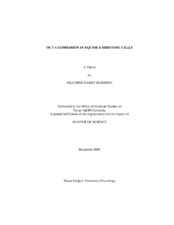| dc.description.abstract | The Oct-4 transcription factor is believed to co-regulate early embryonic
development of mammals due to the correlation of its presence with the maintenance of
pluripotency. It is commonly used as a marker for the identification of embryonic stem
(ES) cells for this reason. Until 1999, Oct-4 studies were limited to in vivo-produced
embryos; equine embryos have not been studied for their Oct-4 expression patterns. In
addition, equine stem-like cells (defined by marker expression, induced differentiation,
passage survival, and morphology) have recently been isolated from in vivo-produced
embryos, but no work has been performed in horses to isolate ES cells from in vitroproduced
embryos.
This study investigated the expression of Oct-4 transcription factor using
immunocytochemistry in 42 in vitro-produced embryos aged 1-10 days and in 5 in vivoproduced
blastocysts aged 7-10 days. Effective conditions for rapid establishment of a
feeder layer of equine fetal fibroblasts were established, and this feeder layer was used to
grow isolated equine inner cell mass (ICM) cells from in vitro-produced embryos. The
expression of Oct-4 was examined in resultant cell growths.
In vitro-produced embryos less than 6 days of age showed variable staining
within blastomeres of the same embryo, and the peak of variability correlated with maternal-zygotic transition. After Oct-4 staining of in vitro-produced blastocysts, no
cells could be identified as an ICM based on a difference in fluorescent intensity from
the other cells of the blasyocysts. However, in vitro-produced blastocysts that were
subsequently cultured in vivo contained a presumptive ICM, visible based on greater
fluorescent intensity of Oct-4 stain. The trophoblast of all blastocysts also stained
positively for Oct-4 protein. Fibroblasts were successfully isolated from equine feti.
Treatment with 20 µg/ml of Mitomycin C arrested cell growth without causing excessive
death. Fibroblasts were inactivated and frozen, then thawed as needed to establish a
confluent monolayer for ICM isolation overnight. ICMs from in vitro-produced
embryos formed outgrowths, but none that could be identified morphologically as ES
cells. Outgrowth cells contained about 20% Oct-4 expressing cells in sporadic
groupings. Assuming appropriate binding of the Oct-4 antibody, Oct-4 expressing cells
(potentially indicating pluripotency) are found throughout the embryo in early
development and in the feeder layer after co-culture. | en |


